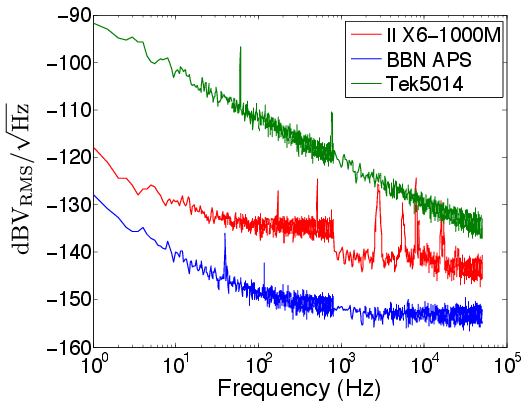Specifications¶
Each unit has four 14-bit 1.2 GS/s analog output channels and four 300 MS/s digital marker channels. The clocks can be synchronized to an external 10 MHz reference. The device can be triggered internally or via an external trigger input. The device uses low-noise linear power supplies with an ultra-low-noise buffer amplifier on the DAC outputs to provide a system noise comparable to a 1 kOhm resistor.
The BBN Arbitrary Pulse Sequencer (APS) is USB slave module with four 1.2 GS/s 14-bit analog output channels and four 300 MS/s digital marker channels. A high-bandwidth amplifier buffers the DAC outputs to drive a 50 ohm load to ±1V full-scale. High-speed LatticeSC3 FPGAs generate 600 MHz DDR sample streams for the DAC channels. Low-skew, low-jitter 300 MHz and 1.2 GHz clocks from a PLL clock generator drive the FPGAs and the DACs. The clocks can be phase locked to an external 10 MHz reference.
The voltage noise of the APS is limited by the noise performance of the last-stage output amplifier, an Analog Devices AD8099. The measured noise at the analog channel outputs is shown in Fig [fig:noise]. Careful engineering of the power supplies and analog/digital ground plane separation lead to system noise performance that is orders of magnitude better than some commonly used waveform generators.

Comparison of AWG output noise. Output noise power versus frequency for the Tektronix AWG5014, Innovative Integration X6-1000M, and BBN APS. The APS’s linear power supplies and low-noise output amplifier lead to signficant improvements in the noise performance. The II X6 is significantly better than the Tek5014, but suffers from resonances in the noise spectrum because it is in a host PC environment.
Detailed Specifications¶
| Parameter | Value |
|---|---|
| Analog channels | four 14-bit 1.2 GS/s outputs |
| Jitter | 28 ps RMS (71 ps peak-to-peak) |
| Rise/fall time | 2ns |
| Settling time | 2 ns to 10%, 10 ns to 1% |
| Digital channels | four 300 MS/s capacitvely coupled outputs |
| Trigger input | 1 V minimum into \(50\,\mathrm{\Omega}\), 5 V maximum; triggered on rising edge |
| Waveform memory | 32,768 samples per channel |
| Sequence memory | 8,192 entries per channel (unlimited with streaming) |
| Minimum sequence pulse length | 12 samples (10 ns) |
| Maximum sequence pulse length | 27 us waveform, or 8 s time-amplitude pair |
| Minimum sequence length | 2 entries |